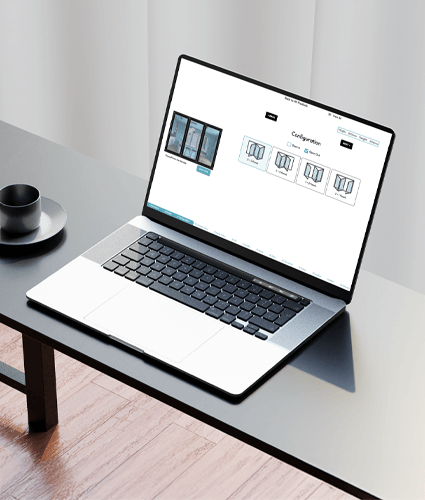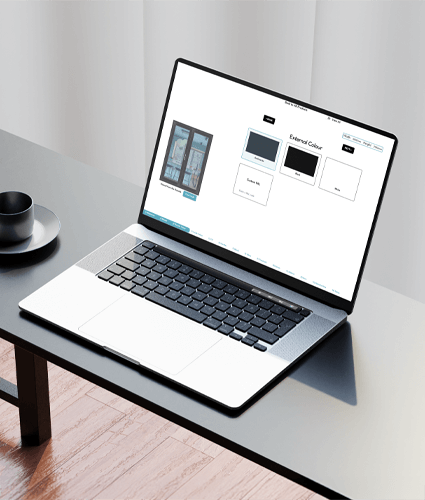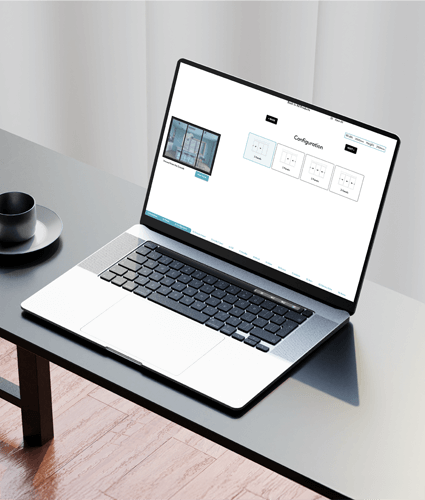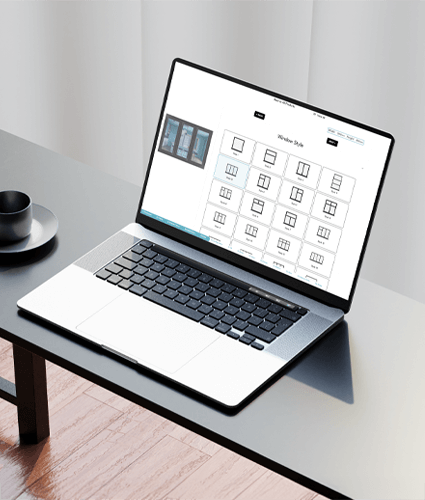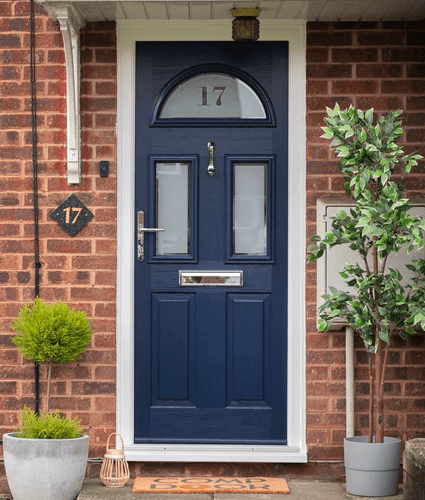
Design Your Door Here
Home » Help & Guides » Aluminium vs uPVC Bifold Doors – Which is Best?
Aluminium vs uPVC Bifold Doors – Which is Best?
uPVC vs Aluminium Bifold Doors: A Comparison Guide
Discover the Rising Popularity of Bifold Doors
Bifold doors, including uPVC and aluminium options, are rapidly gaining popularity in homes and offices. They effectively open up internal spaces, creating a lighter, more seamless flow. These doors are an excellent way to connect indoor spaces with the outdoors, welcoming natural light and providing a clear view of gardens, patios, or other attractive areas.
The Appeal of uPVC Bifold Doors
Recent advances in materials and design have made uPVC bifold doors a modern alternative to traditional French doors, which can now seem a bit outdated. Installing bifold doors not only enhances the aesthetic appeal of your home but can also significantly increase its value.
The Advantages of Aluminium Bifold Doors
Aluminium bifold doors offer strength, durability, and a sleek appearance, making them an excellent choice for any modern home or office. Their slim profiles allow for larger glass panels, maximising natural light and creating an unobstructed view.
When it comes to bifold doors, a common debate arises around whether uPVC or aluminium is the superior choice. Which material is best suited for your new fixture?
In this article, we’ll examine the benefits of these two high-quality materials to determine if one stands out as the clear winner for bifold doors.
Comparing Aluminium and uPVC in Bifold Doors
Bifold doors, also known as bi-folding doors, are a versatile door system comprising multiple panels that fold back on themselves to create a wide, open space. These doors typically feature durable and lightweight frames, with panels made from materials like glass, wood, or uPVC.
Among the popular choices for modern bifold door systems are aluminium and uPVC. Both materials offer sleek designs and are known for their resilience, providing numerous benefits in terms of aesthetics, insulation, and energy efficiency.
Here’s a quick overview of their core properties:
- uPVC (Unplasticised Polyvinyl Chloride): uPVC is a type of rigid plastic widely used for windows, doors, and other building materials. Unlike PVC, it does not contain plasticisers, which makes it more resistant to chemicals, sunlight, and weathering.
- Aluminium: Aluminium is a lightweight, silvery-white metal known for its strength and durability. It is used in a variety of applications due to its excellent thermal and electrical conductivity.
Lifespan Comparison: uPVC vs Aluminium Bifold Doors
Aluminium bifold doors, when well-made and properly maintained, can last anywhere from 20 to 30 years or more. With regular care such as periodic cleaning and lubrication, their lifespan can be extended even further.
Similarly, a high-quality uPVC bifold door can also last into its 20s with good care and maintenance.
In the long run, however, uPVC bifold doors are likely to need replacing sooner than their aluminium counterparts. This highlights the remarkable long-term durability of aluminium.
Interested in aluminium? Read our guide to the best bifold doors and brands in the UK now for more information.
Aluminium vs uPVC Bifold Doors: Price Comparison
When deciding between aluminium and uPVC bifold doors, price is a critical factor. Let’s address this first.
Aluminium bifold doors are generally more expensive than uPVC bifold doors due to the higher cost of aluminium. Here’s a comparison of estimated costs:
Aluminium Anthracite Grey:
- 1.8m – £1,845
- 2.4m – £1,875
- 3.0m – £1,925
- 3.6m – £1,985
uPVC Anthracite Grey:
- 1.8m – £1,720
- 2.4m – £1,850
- 3.0m – £2,200
- 3.6m – £2,399
This comparison shows that uPVC doors are initially more cost-effective. However, considering this as an investment, it’s essential to take a long-term view.
Both aluminium and uPVC are durable materials, but uPVC frames tend to wear out faster. Typically, uPVC bifold doors will need replacing sooner than aluminium ones.
Additionally, aluminium doors often come with a longer warranty period, up to 15 years, compared to around 10 years for uPVC. Factoring in the longer lifespan and extended warranty, the cost-effectiveness of aluminium doors improves over the medium to long term.
For further details, check out our bifold door cost guide.
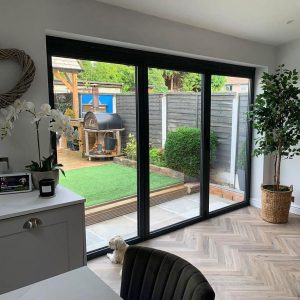
Comparing the Strength of uPVC vs Aluminium Bifold Doors
When it comes to the strength of bifold doors, both uPVC and aluminium are robust materials, but they differ in their composition and overall durability.
uPVC (Unplasticised Polyvinyl Chloride): uPVC is created using a vinyl polymer bonded with chlorine, resulting in a non-plastic compound that is strong enough to be reinforced with steel. This combination offers significant durability, making uPVC a reliable choice for many applications.
Aluminium: Aluminium undergoes a chemical process that combines high-strength alloys and additives, creating a material that is exceptionally strong and durable. Aluminium’s impressive weight-to-strength ratio allows it to be used in constructing skyscrapers and makes it ideal for exterior doors that will experience heavy use.
While both materials are strong, aluminium generally surpasses uPVC in terms of innate strength. This makes aluminium an excellent choice for bifold doors that require superior durability and resilience.
Both aluminium and uPVC bifold doors are capable of supporting double and triple-glazing insulation, ensuring excellent thermal performance and energy efficiency.
Durability and Wear: Aluminium vs uPVC Bifold Doors
Aluminium Bifold Doors:
Aluminium is known for its durability. A well-constructed, treated, and installed aluminium bifold door is typically highly resistant to corrosion, rust, and wear. However, in harsh conditions or coastal areas, corrosion can still be a factor. A powder-coated finish is particularly effective at preventing this.
Aluminium bifold doors are less prone to warping, making them an excellent choice for warmer climates or summer houses. While powder-coated aluminium doors can get scratched, which may lead to corrosion, modern finishes and proper maintenance can mitigate these issues.
uPVC Bifold Doors:
uPVC is engineered to resist chemicals, sunlight, and wear. It’s durable across various climates and has a good tolerance against warping or bending. However, over extended exposure to extreme weather, some warping may occur, which can affect the door’s performance.
uPVC doors are more likely to show signs of wear over time compared to aluminium. They can develop a pink or yellow tinge from continuous UV exposure, especially the plain white versions. There are, however, colour and finish options available to address these issues.
Colour and Style Options for Bifold Doors
When discussing colours, the term RAL often comes up. The RAL Classic system is an industry-recognised range used for powder coating, varnishes, and plastics.
Aluminium Bifold Doors: The powder-coated finish on aluminium bifold doors is available in a vast array of RAL colours. Whether you prefer a sleek contemporary look with neutral palettes or want something bold like red or avocado green, professional manufacturers can accommodate your preferences. Aluminium’s ability to have slimmer frames adds to its stylish appeal.
uPVC Bifold Doors: Historically, uPVC fixtures lacked the customisation options available for aluminium. However, today uPVC doors can also be finished in many RAL colours and finishes, including wood-effect. Despite this, uPVC may not achieve the same warmth and stylish aesthetics as aluminium.
In summary, aluminium bifold doors often offer a more stylish appearance and greater flexibility in design choices, thanks to the wide range of RAL colours and the possibility of slimmer frames.
Sightlines: Aluminium vs uPVC Bifold Doors
When evaluating bifold doors, one of the key factors to consider is the sightline—the non-glass section of the door frame. The sightline can greatly impact the openness and the quality of the view through the door.
Aluminium Bifold Doors: Due to the inherent strength of aluminium, these doors can support slimmer frames while maintaining stability and security. This allows for larger glass panels and minimal sightlines, providing a more expansive and uninterrupted view. Aluminium’s superior weight-to-strength ratio makes it the preferred choice for achieving sleek, ultra-slim frames without compromising on durability.
uPVC Bifold Doors: While uPVC is also a strong material, it cannot match the slim profiles achievable with aluminium. uPVC frames tend to be thicker, which means a larger sightline and slightly less glass. Although uPVC doors are durable and offer good insulation, they generally provide a less open view compared to their aluminium counterparts.
Overall, aluminium bifold doors lead the way in offering minimal sightlines, making them ideal for those looking to maximise their view and achieve a modern, streamlined aesthetic.
Security Features of Aluminium vs uPVC Bifold Doors
Both aluminium and uPVC bifold doors are designed with security in mind, making them suitable for both domestic and commercial applications. Enhanced security measures may be required depending on the level of protection needed for the door panels.
Aluminium and uPVC bifold doors are robust enough to incorporate fortified glass, PVC, and other protective panels. Various locking mechanisms can be installed, such as twin-point locks, euro cylinders, and deadbolt locks, providing a high level of security.
Additional safety features can include child locks, fingerprint scanners, and even bulletproof glass, ensuring comprehensive security solutions for your bifold doors.
For further details on bifold door security, check out our comprehensive guide.
Noise Insulation: Aluminium vs uPVC Bifold Doors
Noise insulation is a critical factor to consider when choosing between aluminium and uPVC bifold doors.
Aluminium Bifold Doors: Due to their metal construction, aluminium frames tend to transmit sound more easily. This can make aluminium bifold doors noisier compared to other materials. However, fitting the doors with double or triple glazing can significantly reduce external noise.
uPVC Bifold Doors: uPVC frames naturally provide better sound insulation than aluminium. This makes uPVC bifold doors particularly suitable for installations near busy roads or other noisy environments, as they help maintain a quieter indoor space.
Stability and Strain: Aluminium vs uPVC Bifold Doors
Frequent and robust use of bifold doors can put significant strain on hinge mechanisms, especially for larger openings with multiple panels.
Aluminium Bifold Doors: Thanks to their superior strength, aluminium bifold doors can better withstand this strain. Additionally, aluminium’s lightweight nature makes large bifold doors easier to open and close compared to uPVC. This results in less force and internal strain on each panel, making aluminium a more suitable choice for doors with a large number of panels.
uPVC Bifold Doors: While durable, uPVC doors are heavier and may put more strain on the hinges over time. This makes uPVC less ideal for larger openings or doors with many panels.
Overall, aluminium bifold doors offer greater stability and are better suited for frequent use and larger installations.
Maintaining Your Bifold Doors: Aluminium vs uPVC
When it comes to maintenance, there’s little difference between aluminium and uPVC bifold doors.
Aluminium Bifold Doors: These doors are low-maintenance, simple to clean, and their durable finish helps them stay looking new for years. Occasional wiping with a damp cloth is typically all that’s needed to keep them in great condition.
uPVC Bifold Doors: uPVC doors also require minimal maintenance. Cleaning them with soap and water occasionally will suffice. However, standard white uPVC doors might need more frequent attention to prevent staining from dirt and grime. In cases where dirt becomes too ingrained, specialist cleaning products may be necessary.
Both materials offer ease of upkeep, ensuring your bifold doors remain functional and aesthetically pleasing with minimal effort.
Thermal Efficiency: Aluminium vs uPVC Bifold Doors
Both uPVC and aluminium bifold doors are known for their excellent insulation properties. However, aluminium, being a better conductor of heat and cold, can allow more temperature transfer compared to uPVC.
This challenge is addressed in modern aluminium bifold doors by incorporating thermal breaks. These polyamide thermal breaks act as barriers that reduce conductivity and energy flow, thereby enhancing the door’s overall energy efficiency. When combined with glazing, these breaks ensure that aluminium frames have minimal impact on your heating, cooling, and fuel bills.
On the other hand, uPVC bifold doors are naturally highly effective at thermal insulation. This inherent property helps in maintaining optimal indoor temperatures, thereby controlling heating and cooling costs efficiently.
Environmental Impact: Aluminium vs uPVC Bifold Doors
Both aluminium and uPVC have long lifespans, which helps reduce their environmental impact over time. Additionally, their excellent energy efficiency contributes positively to the environment.
Aluminium: This material is highly recyclable. Recycling aluminium requires only about 5% of the energy needed to produce new aluminium, making it an energy-efficient and cost-effective process. Its high recyclability rate and lower energy consumption in production give aluminium a significant eco-friendly edge.
uPVC: Although uPVC can also be recycled and many manufacturers have active recycling programs, its recycling rates are lower compared to aluminium. The production process of uPVC consumes more energy, and the disposal of non-biodegradable uPVC and PVC in landfills is an environmental concern.
In summary, aluminium typically has a longer lifespan, requires less energy to produce, and boasts a better recycling record, giving it an eco-friendly advantage over uPVC.
Summary of uPVC vs Aluminium Bifold Doors
In this detailed comparison, aluminium stands out as the superior choice in several key areas:
Aluminium Triumphs In:
- Longevity
- Environmental Impact
- Sightlines
- Strength
- Durability and Wear Resistance
- Style and Customization
- Stability and Strain
uPVC Excels In:
- Noise Insulation
- Thermal Efficiency
Although uPVC offers a lower initial cost, considering factors like lifespan and warranties narrows the price gap between the two. Ultimately, the choice between uPVC and aluminium bifold doors depends on personal preferences, specific needs, and budget. However, our analysis suggests that aluminium is the superior option for bifold doors overall.

